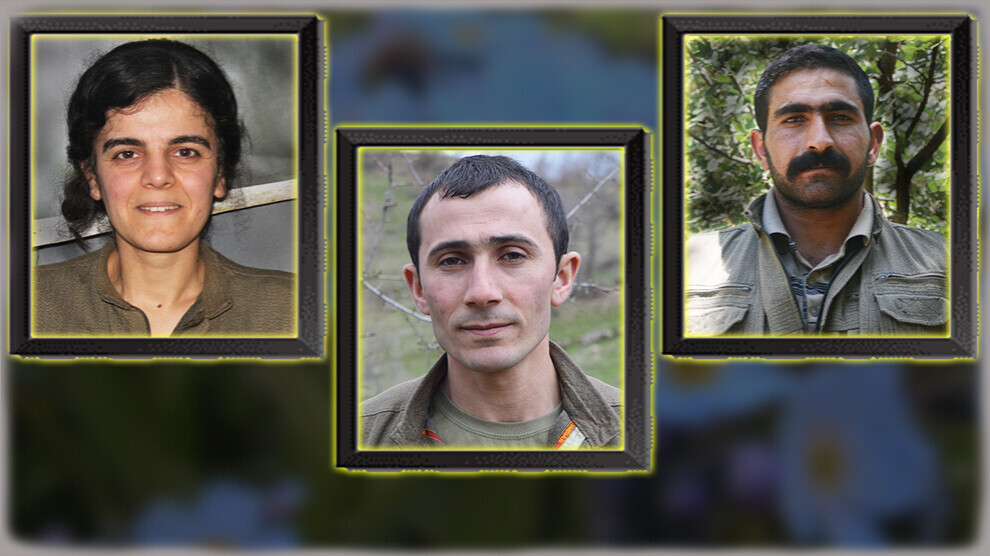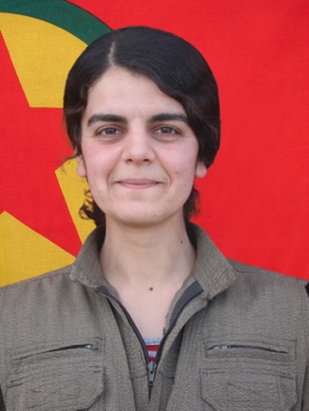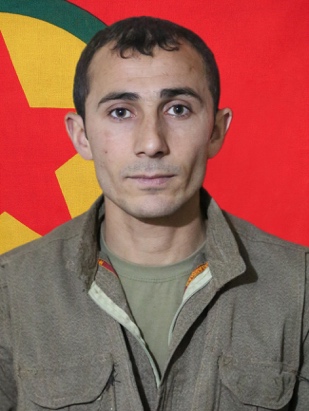HPG pays tribute to guerrillas Sema, Bahoz and Fırat
Guerrillas Sema Cuya Çewlîk, Bahoz Hewlêr and Fırat Harun were killed in an attack by the Turkish army in Xakurke, said the HPG in a statement.
Guerrillas Sema Cuya Çewlîk, Bahoz Hewlêr and Fırat Harun were killed in an attack by the Turkish army in Xakurke, said the HPG in a statement.

The People's Defense Forces (HPG) have announced the deaths of guerrillas Sema Cuya Çewlîk, Bahoz Hewlêr and Fırat Harun. The guerrillas were killed in an attack by the Turkish army in the Xakurke region of South Kurdistan in April. The HPG expressed their condolences to their families and the Kurdish people and said that they would continue the resistance of the martyrs.
The HPG provided the following information about the identities of the guerrillas:
 Code name: Sema Cuya Çewlîk
Code name: Sema Cuya Çewlîk
First and last name: Zilan Azak
Place of birth: Çewlîg
Names of mother and father: Gülten – Yüksel
Time and place of death: April 2024, Xakurke
 Code name: Bahoz Hewlêr
Code name: Bahoz Hewlêr
First and last name: Fawaz Oso
Place of birth: Kobanê
Names of mother and father: Edûle – Mahmud
Time and place of death: April 2024, Xakurke
 Code name: Fırat Harun
Code name: Fırat Harun
First and last name: Halef Karacan
Place of birth: Riha
Names of mother and father: Saliha – Mehmet
Time and place of death: April 2024, Xakurke
Sema Cuya Çewlîk
Sema Cuya Çewlîk was born in Bingöl (Çewlîg) in North Kurdistan. She grew up in a home influenced by Kurdish culture and close to the liberation struggle; her uncle Nurettin Azak had joined the PKK in 1993. She became politicized as a teenager. She was intensively concerned with two central issues: the state, which acts with genocidal intent in Kurdistan, and the question of women and the role assigned to them by society and the state.
Sema rejected the state system and the male-dominated mentality. Her search for an alternative led her to intensively read the philosophy of Abdullah Öcalan, the central pillar of which is the liberation of women. Since the beginning of the Kurdish freedom struggle, the PKK's mastermind has pointed out that the liberation of society is impossible without the liberation of women.
Sema Cuya Çewlîk became politically active with the Revolutionary Youth of Kurdistan. A decisive factor in joining the movement was her father's situation. The journalist Yüksel Azak was arrested in 2007. His journalistic work was interpreted as "terrorism". He was only released from prison in 2017 - only to be arrested again soon after. By then, his daughter had already joined the guerrillas.
Sema Cuya Çewlîk left the university in Bitlis (Bedlîs) in 2015 and went to the mountains; a few months after the liberation of Kobanê in the course of the attack by the Islamic State and the beginning of the Turkish state's total annihilation campaign in Kurdistan as a result of the unilateral termination of the dialogue process with Abdullah Öcalan.
She joined the guerrilla in Garzan, where she also received her basic training and gained her first practical experience. She then moved to the Medya Defense Areas, where she learned modern guerrilla tactics and specialized in the use of heavy weapons. Before she went to Xakurke, she was deployed for many years in Metîna, Zap and Avaşîn.
Bahoz Hewlêr
Bahoz Hewlêr was born in Kobanê in western Kurdistan. His family belongs to the Kêtikî tribe, which is known for its traditional resistance. Due to the political environment and proximity to the liberation struggle, Bahoz Hewlêr was familiar with the PKK from an early age. As he grew older, he got to know the Kurdish movement better and explored its ideas. When ISIS overran parts of Iraq and Syria in 2014 and also targeted Rojava, he joined the YPG to defend the revolution and took part in the battle for Kobanê.
After the victory over ISIS - the jihadists were expelled from the city in January 2015 - Bahoz Hewlêr joined the PKK. "He wanted to take the fight for his people to another level," said the HPG in its obituary. When he joined the guerrillas, he expressed his desire to fight in Bakur. Due to the war-related situation, his proposal was rejected. He specifically focused on various branches in the military field and acquired expert knowledge in handling different branches of the military. He put this knowledge into practice in regions within the Medya Defense Areas from 2018 onwards.
As the Turkish occupation operations in South Kurdistan intensified, Bahoz Hewlêr moved to the front lines of the war. He took part in almost all guerrilla offensives against the invasion. In Xakurke, he was deployed at his own request.
Fırat Harun
Fırat Harun came from Hilvan (Curnê Reş), which was symbolically important for the Kurdish movement. Influenced by the experience of the population of the city in the province of Urfa (Riha) - a handful of PKK members, who were then called "Kurdistan revolutionaries", had taken up the fight against collaboration in Curnê Reş in the late 1970s and planted the seeds of the revolution - as well as the sympathy of his family for the Kurdish movement, he felt an affinity with the PKK from an early age.
Fırat Harun first became involved in political activism while studying at the university in the northern Turkish province of Çankırı. The decisive factors were fascist and racist attacks on Kurdish students and the principle of enemy criminal law, which Kurds are constantly experiencing all over the country. His connection to the Kurdish youth movement coincided with the attacks on Rojava. He left the university and joined the guerrillas in Amed (Diyarbakir).
Fırat Harun's plan after arriving in the Medya Defense Areas was actually to go from there to Kobanê and take part in the fight against ISIS. This wish could not be fulfilled. On 30 October 2014, the fascist AKP-MHP government and the war institution known as the National Security Council met in Ankara to formulate their "Çöktürme Planı" (crash plan) against the Kurdish population. The plan was developed during the dialogue process with Abdullah Öcalan and marked the beginning of a new cycle of chaos and massacres against Kurds that has now far surpassed the dark 1990s.
Between 2013 and 2015, there were talks between the PKK and the Turkish state with the aim of working out a democratic solution to the Kurdish question. On 24 July 2015, the phase of dialogue between the Turkish state and the Kurdish liberation movement was officially declared over with the bombing of the Qandil Mountains in South Kurdistan by the Turkish Air Force. The unilateral termination of the peace process marked the beginning of a total war of annihilation against the Kurdish people, which cost countless lives.
Fırat Harun stayed in South Kurdistan. Through various training and further education programs of the guerrillas, he acquired in-depth knowledge of the art of war - tactics, operational art and strategy - which he passed on to his comrades. Like Sema Cuya Çewlîk and Bahoz Hewlêr, he was deployed in various regions of the Medya Defense Areas. In Xakurke, he was one of the fighters who built and expanded the tunnel network and other infrastructure of the guerrillas.